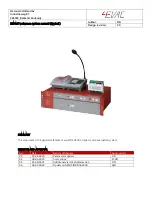
5
Instruction Booklet
IB022003EN
Effective April 2018
Revision #3
Instructions for installation, operation, and
maintenance of Type MVS-ND, metal-enclosed
switchgear assemblies: 4.76 kV or 15.0 kV class
EATON
www.eaton.com
Safety precautions
WARNING
ONLY QUALIFIED ELECTRICAL WORKERS WITH TRAINING AND
EXPERIENCE ON HIGH VOLTAGE CIRCUITS SHOULD BE PERMITTED
TO WORK ON THIS EQUIPMENT. THEY SHOULD BE FAMILIAR WITH
THE WORK TO BE PERFORMED, THE SAFETY EQUIPMENT REQUIRED,
AND THE HAZARDS INVOLVED.
1.
Read and understand these instructions before attempting
any assembly, operation, or maintenance of an MVS-ND
switchgear assembly .
2.
Disconnect all low voltage and medium voltage power sources
before working on the equipment per Occupational Safety and
Health Act (OSHA) and local lockout and tagout procedures .
Verify voltages have been removed, ground both load and
line side connections . Observe the National Fire Protection
Association’s (NFPA
T
) Publication #70 that is commonly known
as the National Electrical Code (NEC
T
), OSHA, and local
procedures and standards . This includes visual inspections
while the vertical section door is open, making any adjustments
inside or outside the switchgear vertical section, performing
maintenance, or installing replacement parts .
3.
The vertical section door cannot be opened with the switch in
the CLOSED position . In addition, the switch cannot be closed
with the vertical section door open .
4.
Before opening the door of the vertical section, look through the
window on the door to ensure that all three main blades and
flicker blades are OPEN . If necessary, use an additional suitable
light source .
WARNING
DEFEATING OR DISENGAGING SAFETY INTERLOCKS ON AN MVS-ND
SWITCH THAT IS PROPERLY INSTALLED IN AN MVS-ND SWITCHGEAR
ASSEMBLY AND CONNECTED TO A POWER SOURCE MAY RESULT IN
PROPERTY DAMAGE, BODILY INJURY, OR DEATH. DO NOT DEFEAT OR
DISENGAGE ANY SAFETY INTERLOCKS WHEN THE SWITCHGEAR IS
IN SERVICE.
Before energizing the switchgear assembly:
5.
Make sure the MVS-ND switchgear assembly is securely
fastened to a true and level surface according to the floor plan of
the customer drawings .
6.
Always be sure that all hardware is in place and secured by
tightening or using safety fasteners before putting an MVS-ND
switch into operation . See Duplex switchgear configuration
on Page 13 .
7.
Confirm that all arc chutes and barriers are installed .
8.
Confirm that no tools or other objects are left inside the
vertical section .
9.
Confirm that all devices, doors, and covers are in place .
10.
Before start up, perform a field power frequency withstand
(Hi-Pot) test, using test voltages given in Table 1 .
Table 1. Power Frequency Withstand Test Voltages.
Rated Maximum Voltage (kV)
Power-Frequency Withstand (rms) (kV)
4.76
14.25
8.25
27
15.0
27
27.0
45
38.0
60
Switchgear identification
A nameplate is located inside the small access door of each type
MVS-ND switchgear vertical section (see Figure 1) . Contained on
this nameplate are the Eaton master parts list number and all the
necessary switchgear ratings . This information should be given to
the Eaton sales office if a question should arise concerning the
switchgear or if renewal parts are required . This information is
sufficient for Eaton to find the manufacturing information for
the switchgear .
Figure 1. Typical Nameplate.
WARNING
EXCEEDING NAMEPLATE RATINGS OF MVS-ND SWITCHGEAR COULD
CAUSE PROPERTY DAMAGE, SEVERE INJURY, OR DEATH. MVS-ND
SWITCHGEAR MUST BE OPERATED WITHIN ITS NAMEPLATE RATINGS.
Safety features
Type MVS-ND load interrupter switchgear has several built-in features
to reduce hazards and to provide proper operating sequences .
1.
A door interlock prevents opening the enclosure’s front door
while the load interrupter switch is in the closed position .
2.
A switch interlock prevents manual operation of the switch’s
operating mechanism with the door open .
3.
A viewing window is provided to visually verify the switch
contact position .
4.
Provisions for padlocking the switch in the open or
closed position .
5.
Provisions for padlocking the main door handles closed .
6.
Mechanical indicators show whether the switch mechanism is
open or closed .
7.
Key interlocks, when provided, force a sequence of operation .






































